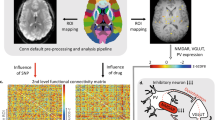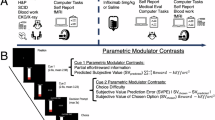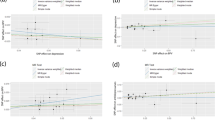Abstract
In patients at high risk for recurrence of malignant melanoma, interferon-α (IFN-α), a stimulator of innate immunity, appears to induce distinct neurobehavioral symptom dimensions: a mood and anxiety syndrome, and a neurovegetative syndrome, of which the former is responsive to prophylactic administration of paroxetine. We sought to determine whether symptom dimensions (and treatment responsiveness) arise in patients with hepatitis C administered IFN-α and ribavirin. In a randomized, double-blind, 6-month study, 61 patients with hepatitis C eligible for therapy with IFN-α and ribavirin received the antidepressant paroxetine (n=28) or a placebo (n=33). Study medication began 2 weeks before IFN-α/ribavirin therapy. Neuropsychiatric assessments included the 10-item Montgomery–Asberg Depression Rating Scale (MADRS). The items of the MADRS were grouped into depression, anxiety, cognitive dysfunction, and neurovegetative symptom dimensions, and analyzed using a mixed model. By 2 weeks of IFN-α/ribavirin therapy, all four dimensions increased, with the symptom dimensions of anxiety and cognitive dysfunction fluctuating and worsening, respectively, in both groups over time. The depression symptom dimension was significantly lower in the paroxetine treatment group (p=0.04); severity of the neurovegetative symptom dimension was similar in both groups. Similar to patients with malignant melanoma receiving high-dose IFN-α, the depression symptom dimension is more responsive to paroxetine treatment in individuals undergoing concomitant IFN-α/ribavirin therapy. However, the anxiety, cognitive dysfunction, and neurovegetative symptom dimensions appear less responsive to prophylactic paroxetine administration. Different neurobiologic pathways may contribute to the responsiveness of IFN-α-induced symptom dimensions to antidepressant treatment, requiring relevant psychopharmacologic strategies.
Similar content being viewed by others
Log in or create a free account to read this content
Gain free access to this article, as well as selected content from this journal and more on nature.com
or
References
Ambermoon P, Carter A, Hall WD, Dissanayaka NN, O’Sullivan JD (2011). Impulse control disorders in patients with Parkinson's disease receiving dopamine replacement therapy: evidence and implications for the addictions field. Addiction 106: 283–293.
American Psychiatric Association (1994). Diagnostic and Statistical Manual of Mental Disorders: DSM-IV 4th edn American Psychiatric Association: Washington, DC.
Auyeung SF, Long Q, Royster EB, Murthy S, McNutt MD, Lawson DH et al (2009). Sequential multiple-assignment randomized trial design of neurobehavioral treatment for patients with metastatic malignant melanoma undergoing high-dose interferon-alpha therapy. Clin Trials 6: 480–490.
Bagaglio S, Cinque P, Racca S, Pedale R, Grasso MA, Lazzarin A et al (2005). Hepatitis C virus populations in the plasma, peripheral blood mononuclear cells and cerebrospinal fluid of HIV/hepatitis C virus-co-infected patients. AIDS 19 (Suppl 3): S151–S165.
Bender CM, Ergyn FS, Rosenzweig MQ, Cohen SM, Sereika SM (2005). Symptom clusters in breast cancer across 3 phases of the disease. Cancer Nurs 28: 219–225.
Bonaccorso S, Marino V, Puzella A, Pasquini M, Biondi M, Artini M et al (2002). Increased depressive ratings in patients with hepatitis C receiving interferon-alpha-based immunotherapy are related to interferon-alpha-induced changes in the serotonergic system. J Clin Psychopharmacol 22: 86–90.
Bull SJ, Huezo-Diaz P, Binder EB, Cubells JF, Ranjith G, Maddock C et al (2009). Functional polymorphisms in the interleukin-6 and serotonin transporter genes, and depression and fatigue induced by interferon-alpha and ribavirin treatment. Mol Psychiatry 14: 1095–1104.
Capuron L, Miller AH (2004). Cytokines and psychopathology: lessons from interferon-alpha. Biol Psychiatry 56: 819–824.
Capuron L, Ravaud A, Dantzer R (2000). Early depressive symptoms in cancer patients receiving interleukin 2 and/or interferon alfa-2b therapy. J Clin Oncol 18: 2143–2151.
Centers for Disease Control and Prevention (2011). Hepatitis C information for health professionals. http://www.cdc.gov/hepatitis/HCV/index.htm.
Chang E, Boyd A, Nelson CC, Crowley D, Law T, Keough KM et al (1997). Successful treatment of infantile hemangiomas with interferon-alpha-2b. J Pediatr Hematol Oncol 19: 237–244.
Chen ML, Tseng HC (2006). Symptom clusters in cancer patients. Support Care Cancer 14: 825–830.
Constant A, Castera L, Dantzer R, Couzigou P, de Ledinghen V, Demotes-Mainard J et al (2005). Mood alterations during interferon-alfa therapy in patients with chronic hepatitis C: evidence for an overlap between manic/hypomanic and depressive symptoms. J Clin Psychiatry 66: 1050–1057.
DiMatteo MR, Lepper HS, Croghan TW (2000). Depression is a risk factor for noncompliance with medical treatment: meta-analysis of the effects of anxiety and depression on patient adherence. Arch Intern Med 160: 2101–2107.
Dodd MJ, Miaskowski C, Paul SM (2001). Symptom clusters and their effect on the functional status of patients with cancer. Oncol Nurs Forum 28: 465–470.
Folstein MF, Folstein SE, McHugh A (1975). ‘Mini-Mental State’: a practical method for grading the cognitive state of patients for the clinician. J Psychiatr Res 12: 189–198.
Forton DM, Thomas HC, Murphy CA, Allsop JM, Foster GR, Main J et al (2002). Hepatitis C and cognitive impairment in a cohort of patients with mild liver disease. Hepatology 35: 433–439.
Ge D, Fellay J, Thompson AJ, Simon JS, Shianna KV, Urban TJ et al (2009). Genetic variation in IL28B predicts hepatitis C treatment-induced viral clearance. Nature 461: 399–401.
Gift AG, Stommel M, Jablonski A, Given W (2003). A cluster of symptoms over time in patients with lung cancer. Nurs Res 52: 393–400.
Giosue S, Casarini M, Ameglio F, Zangrilli P, Palla M, Altieri AM et al (2000). Aerosolized interferon-alpha treatment in patients with multi-drug-resistant pulmonary tuberculosis. Eur Cytokine Netw 11: 99–104.
Guillemin GJ, Wang L, Brew BJ (2005). Quinolinic acid selectively induces apoptosis of human astrocytes: potential role in AIDS dementia complex. J Neuroinflammation 2: 16.
Hammond MF (1998). Rating depression severity in the elderly physically ill patient: reliability and factor structure of the Hamilton and the Montgomery–Asberg depression rating scales. Int J Geriatr Psychiatry 13: 257–261.
Hauser P, Khosla J, Aurora H, Laurin J, Kling MA, Hill J et al (2002). A prospective study of the incidence and open-label treatment of interferon-induced major depressive disorder in patients with hepatitis C. Mol Psychiatry 7: 942–947.
Haward LR (1979). Multivariate symptom analysis related to response to lorazepam treatment. Curr Med Res Opin 6: 20–23.
Ho SB, Nguyen H, Tetrick LL, Opitz GA, Basara ML, Dieperink E (2001). Influence of psychiatric diagnoses on interferon-alpha treatment for chronic hepatitis C in a veteran population. Am J Gastroenterol 96: 157–164.
Horikawa N, Yamazaki T, Sagawa M, Nagata T (1999). A case of akathisia during interferon-alpha therapy for chronic hepatitis type C. Gen Hosp Psychiatry 21: 134–135.
Hosoda S, Takimura H, Shibayama M, Kanamura H, Ikeda K, Kumada H (2000). Psychiatric symptoms related to interferon therapy for chronic hepatitis C: clinical features and prognosis. Psychiatry Clin Neurosci 54: 565–572.
Kamata M, Higuchi H, Yoshimoto M, Yoshida K, Shimizu T (2000). Effect of single intracerebroventricular injection of alpha-interferon on monoamine concentrations in the rat brain. Eur Neuropsychopharmacol 10: 129–132.
Kearns NP, Cruickshank CA, McGuigan KJ, Riley SA, Shaw SP, Snaith RP (1982). A comparison of depression rating scales. Br J Psychiatry 141: 45–49.
Kelley KW, Bluthe RM, Dantzer R, Zhou JH, Shen WH, Johnson RW et al (2003). Cytokine-induced sickness behavior. Brain Behav Immun 17 (Suppl 1): S112–S118.
Khan A, Brodhead AE, Kolts RL (2004). Relative sensitivity of the Montgomery–Asberg depression rating scale, the Hamilton depression rating scale and the clinical global impressions rating scale in antidepressant clinical trials: a replication analysis. Int Clin Psychopharmacol 19: 157–160.
Kim HJ, McGuire DB, Tulman L, Barsevick AM (2005). Symptom clusters: concept analysis and clinical implications for cancer nursing. Cancer Nurs 28: 270–282.
Kirkova J, Walsh D (2007). Cancer symptom clusters—a dynamic construct. Support Care Cancer 15: 1011–1013.
Kirkova J, Walsh D, Aktas A, Davis MP (2010). Cancer symptom clusters: old concept but new data. Am J Hosp Palliat Care 27: 282–288.
Kraus MR, Schafer A, Csef H, Faller H, Mork H, Scheurlen M (2001). Compliance with therapy in patients with chronic hepatitis C: associations with psychiatric symptoms, interpersonal problems, and mode of acquisition. Dig Dis Sci 46: 2060–2065.
Kumai T, Tateishi T, Tanaka M, Watanabe M, Shimizu H, Kobayashi S (2000). Effect of interferon-alpha on tyrosine hydroxylase and catecholamine levels in the brain of rats. Life Sci 67: 663–669.
Lang CA, Conrad S, Garrett L, Battistutta D, Cooksley WG, Dunne MP et al (2006). Symptom prevalence and clustering of symptoms in people living with chronic hepatitis C infection. J Pain Symptom Manage 31: 335–344.
Laskus T, Radkowski M, Bednarska A, Wilkinson J, Adair D, Nowicki M et al (2002). Detection and analysis of hepatitis C virus sequences in cerebrospinal fluid. J Virol 76: 10064–10068.
Lindsay KL (1997). Therapy of hepatitis C: overview. Hepatology 26 (3 Suppl 1): 71S–77S.
Loftis JM, Huckans M, Ruimy S, Hinrichs DJ, Hauser P (2008). Depressive symptoms in patients with chronic hepatitis C are correlated with elevated plasma levels of interleukin-1beta and tumor necrosis factor-alpha. Neurosci Lett 430: 264–268.
Lotrich FE, Loftis JM, Ferrell RE, Rabinovitz M, Hauser P (2011). IL28B polymorphism is associated with both side effects and clearance of hepatitis C during interferon-alpha therapy. J Interferon Cytokine Res 31: 331–336.
Maggi F, Giorgi M, Fornai C, Morrica A, Vatteroni ML, Pistello M et al (1999). Detection and quasispecies analysis of hepatitis C virus in the cerebrospinal fluid of infected patients. J Neurovirol 5: 319–323.
Mahrer AR, Mason DJ, Rosenshine M (1966). A headache syndrome in psychiatric patients: symptom clusters accompanying headaches. J Clin Psychol 22: 411–414.
Manesis EK, Hadziyannis SJ (2001). Interferon alpha treatment and retreatment of hepatitis B e antigen-negative chronic hepatitis B. Gastroenterology 121: 101–109.
McHutchison JG, Gordon SC, Schiff ER, Shiffman ML, Lee WM, Rustgi VK et al (1998). Interferon alfa-2b alone or in combination with ribavirin as initial treatment for chronic hepatitis C. Hepatitis Interventional Therapy Group. N Engl J Med 339: 1485–1492.
Miaskowski C, Dodd M, Lee K (2004). Symptom clusters: the new frontier in symptom management research. J Natl Cancer Inst Monogr 32: 17–21.
Miller AH (2009). Norman cousins lecture. Mechanisms of cytokine-induced behavioral changes: psychoneuroimmunology at the translational interface. Brain Behav Immun 23: 149–158.
Montgomery SA, Asberg M (1979). A new depression scale designed to be sensitive to change. Br J Psychiatry 134: 382–389.
Morasco BJ, Loftis JM, Indest DW, Ruimy S, Davison JW, Felker B et al (2010). Prophylactic antidepressant treatment in patients with hepatitis C on antiviral therapy: a double-blind, placebo-controlled trial. Psychosomatics 51: 401–408.
Morasco BJ, Rifai MA, Loftis JM, Indest DW, Moles JK, Hauser P (2007). A randomized trial of paroxetine to prevent interferon-alpha-induced depression in patients with hepatitis C. J Affect Disord 103: 83–90.
Morsica G, Bernardi MT, Novati R, Uberti Foppa C, Castagna A, Lazzarin A (1997). Detection of hepatitis C virus genomic sequences in the cerebrospinal fluid of HIV-infected patients. J Med Virol 53: 252–254.
Murray J, Fishman SL, Ryan E, Eng FJ, Walewski JL, Branch AD et al (2008). Clinicopathologic correlates of hepatitis C virus in brain: a pilot study. J Neurovirol 14: 17–27.
O’Connor JC, Lawson MA, Andre C, Moreau M, Lestage J, Castanon N et al (2009). Lipopolysaccharide-induced depressive-like behavior is mediated by indoleamine 2,3-dioxygenase activation in mice. Mol Psychiatry 14: 511–522.
Oxenkrug G, Perianayagam M, Mikolich D, Requintina P, Shick L, Ruthazer R et al (2011). Interferon-gamma (+874) T/A genotypes and risk of IFN-alpha-induced depression. J Neural Transm 118: 271–274.
Pemberton LA, Kerr SJ, Smythe G, Brew BJ (1997). Quinolinic acid production by macrophages stimulated with IFN-gamma, TNF-alpha, and IFN-alpha. J Interferon Cytokine Res 17: 589–595.
Poynard T, Marcellin P, Lee SS, Niederau C, Minuk GS, Ideo G et al (1998). Randomised trial of interferon alpha2b plus ribavirin for 48 weeks or for 24 weeks vs interferon alpha2b plus placebo for 48 weeks for treatment of chronic infection with hepatitis C virus. International Hepatitis Interventional Therapy Group (IHIT). Lancet 352: 1426–1432.
Raison CL, Borisov AS, Broadwell SD, Capuron L, Woolwine BJ, Jacobson IM et al (2005a). Depression during pegylated interferon-alpha plus ribavirin therapy: prevalence and prediction. J Clin Psychiatry 66: 41–48.
Raison CL, Broadwell SD, Borisov AS, Manatunga AK, Capuron L, Woolwine BJ et al (2005b). Depressive symptoms and viral clearance in patients receiving interferon-alpha and ribavirin for hepatitis C. Brain Behav Immun 19: 23–27.
Raison CL, Dantzer R, Kelley KW, Lawson MA, Woolwine BJ, Vogt G et al (2010). CSF concentrations of brain tryptophan and kynurenines during immune stimulation with IFN-alpha: relationship to CNS immune responses and depression. Mol Psychiatry 15: 393–403.
Raison CL, Woolwine BJ, Demetrashvili MF, Borisov AS, Weinreib R, Staab JP et al (2007). Paroxetine for prevention of depressive symptoms induced by interferon-alpha and ribavirin for hepatitis C. Alimentary Pharm Therapeutics 25: 1163–1174.
Rubin DB (1976). Inference and missing data. Biometrika 63: 581–592.
Schaefer M, Schwaiger M, Pich M, Lieb K, Heinz A (2003). Neurotransmitter changes by interferon-alpha and therapeutic implications. Pharmacopsychiatry 36 (Suppl 3): S203–S206.
Serretti A, Mandelli L (2010). Antidepressants and body weight: a comprehensive review and meta-analysis. J Clin Psychiatry 71: 1259–1272.
Seyam MS, Freshwater DA, O’Donnell K, Mutimer DJ (2005). Weight loss during pegylated interferon and ribavirin treatment of chronic hepatitis C*. J Viral Hepat 12: 531–535.
Shuto H, Kataoka Y, Horikawa T, Fujihara N, Oishi R (1997). Repeated interferon-alpha administration inhibits dopaminergic neural activity in the mouse brain. Brain Res 747: 348–351.
Su KP, Huang SY, Peng CY, Lai HC, Huang CL, Chen YC et al (2010). Phospholipase A2 and cyclooxygenase 2 genes influence the risk of interferon-alpha-induced depression by regulating polyunsaturated fatty acids levels. Biol Psychiatry 67: 550–557.
Sunami M, Nishikawa T, Yorogi A, Shimoda M (2000). Intravenous administration of levodopa ameliorated a refractory akathisia case induced by interferon-alpha. Clin Neuropharmacol 23: 59–61.
Talpaz M, Kantarjian H, Kurzrock R, Trujillo JM, Gutterman JU (1991). Interferon-alpha produces sustained cytogenetic responses in chronic myelogenous leukemia. Philadelphia chromosome-positive patients. Ann Intern Med 114: 532–538.
Teva Pharmaceuticals USA Inc. (2011). Paroxetine. http://www.drugs.com/pro/paroxetine.html.
Valentine AD, Meyers CA, Kling MA, Richelson E, Hauser P (1998). Mood and cognitive side effects of interferon-alpha therapy. Semin Oncol 25 (Suppl 1): 39–47.
Vargas HE, Laskus T, Radkowski M, Wilkinson J, Balan V, Douglas DD et al (2002). Detection of hepatitis C virus sequences in brain tissue obtained in recurrent hepatitis C after liver transplantation. Liver Transpl 8: 1014–1019.
Vecsei L, Beal MF (1990). Influence of kynurenine treatment on open-field activity, elevated plus-maze, avoidance behaviors and seizures in rats. Pharmacol Biochem Behav 37: 71–76.
Walsh D, Donnelly S, Rybicki L (2000). The symptoms of advanced cancer: relationship to age, gender, and performance status in 1000 patients. Support Care Cancer 8: 175–179.
Walsh D, Rybicki L (2006). Symptom clustering in advanced cancer. Support Care Cancer 14: 831–836.
Wang XS, Fairclough DL, Liao Z, Komaki R, Chang JY, Mobley GM et al (2006). Longitudinal study of the relationship between chemoradiation therapy for non-small-cell lung cancer and patient symptoms. J Clin Oncol 24: 4485–4491.
Weissenborn K, Ennen JC, Bokemeyer M, Ahl B, Wurster U, Tillmann H et al (2006). Monoaminergic neurotransmission is altered in hepatitis C virus infected patients with chronic fatigue and cognitive impairment. Gut 55: 1624–1630.
Wheatley K, Ives N, Hancock B, Gore M, Eggermont A, Suciu S (2003). Does adjuvant interferon-alpha for high-risk melanoma provide a worthwhile benefit? A meta-analysis of the randomised trials. Cancer Treat Rev 29: 241–252.
Wichers MC, Koek GH, Robaeys G, Praamstra AJ, Maes M (2005). Early increase in vegetative symptoms predicts IFN-alpha-induced cognitive-depressive changes. Psychol Med 35: 433–441.
Wilkie MJ, Smith G, Day RK, Matthews K, Smith D, Blackwood D et al (2009). Polymorphisms in the SLC6A4 and HTR2A genes influence treatment outcome following antidepressant therapy. Pharmacogenomics J 9: 61–70.
Williams GW, Barton GM, White AA, Won H (1976). Cluster analysis applied to symptom ratings of psychiatric patients: an evaluation of its predictive ability. Br J Psychiatry 129: 178–185.
Yates WR, Gleason O (1998). Hepatitis C and depression. Depress Anxiety 7: 188–193.
Yonkers KA, Samson J (2000). Mood disorders measures. In: Rush AJ, Pincus HA, First MB, et al (eds) Handbook of Psychiatric Measures. American Psychiatric Association: Washington, DC. pp 515–549.
Yoon JC, Crane PK, Ciechanowski PS, Harrington RD, Kitahata MM, Crane HM (2011). Somatic symptoms and the association between hepatitis C infection and depression in HIV-infected patients. AIDS Care 23: 1208–1218.
Yoshida K, Alagbe O, Wang X, Woolwine B, Thornbury M, Raison CL et al (2005). Promoter polymorphisms of the interferon-alpha receptor gene and development of interferon-induced depressive symptoms in patients with chronic hepatitis C: preliminary findings. Neuropsychobiology 52: 55–61.
Zdilar D, Franco-Bronson K, Buchler N, Locala JA, Younossi ZM (2000). Hepatitis C, interferon alfa, and depression. Hepatology 31: 1207–1211.
Acknowledgements
We thank the many patients who gave their time and effort to help complete this study. The trial is registered with ClinicalTrials.gov under identifier NCT00352885. This work was supported by Schering-Plough and GlaxoSmithKline, and by grants from the National Institute of Mental Health (MH060723, MH64619, MH00680, MH071580, and MH60723) and an NIH/NCRR General Clinical Research Center grant (M01 RR00039).
Author information
Authors and Affiliations
Corresponding author
Ethics declarations
Competing interests
Charles L Raison serves as a consultant for Biolex Therapeutics and Pamlab. Andrew H Miller has served as consultant for Abbott Laboratories, AstraZeneca, GlaxoSmithKline, Lundbeck Research USA, F Hoffmann-La Roche, Schering-Plough Research Institute, and Wyeth/Pfizer, and has received research support from Centocor, GlaxoSmithKline, and Schering-Plough Research Institute. The remaining authors declare no conflict of interest.
PowerPoint slides
Rights and permissions
About this article
Cite this article
McNutt, M., Liu, S., Manatunga, A. et al. Neurobehavioral Effects of Interferon-α in Patients with Hepatitis-C: Symptom Dimensions and Responsiveness to Paroxetine. Neuropsychopharmacol 37, 1444–1454 (2012). https://doi.org/10.1038/npp.2011.330
Received:
Revised:
Accepted:
Published:
Issue date:
DOI: https://doi.org/10.1038/npp.2011.330
Keywords
This article is cited by
-
Interleukin-8 and depressive responses to an inflammatory challenge: secondary analysis of a randomized controlled trial
Scientific Reports (2022)
-
Type 1 interferon mediates chronic stress-induced neuroinflammation and behavioral deficits via complement component 3-dependent pathway
Molecular Psychiatry (2021)
-
A case report of psychiatric symptoms following direct-acting antiviral and ribavirin combination therapy for chronic hepatitis C in a patient with innate anxiety
BMC Gastroenterology (2019)
-
Role of neuro-immunological factors in the pathophysiology of mood disorders
Psychopharmacology (2016)
-
Persistent neurocognitive decline in a clinic sample of hepatitis C virus-infected persons receiving interferon and ribavirin treatment
Journal of NeuroVirology (2014)



